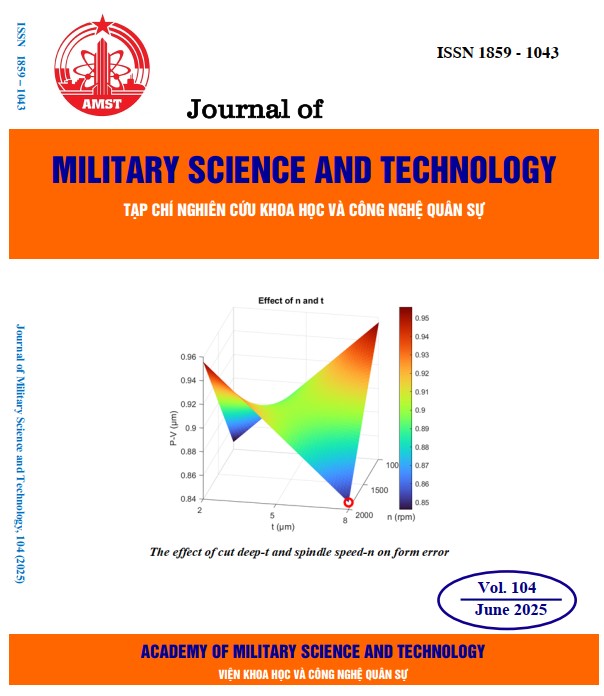Mô hình hóa và phân tích động lực học trạm lọc nước dã chiến khi di chuyển có xét đến biên dạng mặt đường
229 lượt xemDOI:
https://doi.org/10.54939/1859-1043.j.mst.104.2025.173-181Từ khóa:
Động lực học; Hệ nhiều vật; Trạm lọc nước; Biên dạng mặt đường; Dao động phương tiện cơ giới; Mô hình VFS 2.5.Tóm tắt
Trong quá trình tác chiến trên chiến trường, trạm lọc nước dã chiến được sử dụng để cung cấp nước sạch cho các đơn vị một trong số đó là trạm lọc nước VFS-2,5. Khi di chuyển, chúng kéo theo rơ-mooc chở máy phát điện và thùng hóa chất phía sau để lọc nước. Mô hình động lực học ở dạng cơ hệ nhiều vật được xây dựng là mô hình phẳng với xe kéo là xe tải hai cầu. Mô hình nghiên cứu xem xét đến sự đàn hồi của hệ thống treo, lốp xe, khớp nối rơ-mooc và bỏ quả ảnh hưởng của độ dốc. Trên cơ sở mô hình động lực học, phương trình La-grăng loại II được sử dụng để xây dựng hệ phương trình vi phân mô tả chuyển động của cơ hệ. Mô hình nghiên cứu có thể được sử dụng để đánh giá độ ổn định của trạm lọc nước và hướng đến cải tiến hệ thống treo trên rơ-mooc kéo máy phát điện nhằm giảm thiểu dao động của tổ hợp. Đây là vấn đề rất có ý nghĩa trong lĩnh vực an ninh quốc phòng.
Tài liệu tham khảo
[1]. M. Boreiry, S. Ebrahimi-Nejad and J. Marzbanrad, “Sensitivity analysis of chaotic vibrations of a full vehicle model with magnetorheological damper”, Chaos. Solitons and Fractals, vol. 127, pp. 428-442, (2019). https://doi.org/10.1016/j.chaos.2019.07.005. DOI: https://doi.org/10.1016/j.chaos.2019.07.005
[2]. Q. Zhu and M. Ishitobi, “Chaotic vibration of a nonlinear full-vehicle model”, International Journal of Solids and Structures, vol. 43, no. 3-4, pp. 747–759, (2006), https://doi.org/10.1016/j.ijsolstr.2005.06.070. DOI: https://doi.org/10.1016/j.ijsolstr.2005.06.070
[3]. Nguyen Minh Kha, Le Van Duong, Tran Duc Thang, "Study on the impact of ground profile on the vibrations of military mobile repair vehicles", Vietnam mechanical Journal, No. 11, pp.154-159, (2024).
[4]. D. W. Park, A. T. Papagiannakis and I. T. Kim, “Analysis of Dynamic Vehicle Loads using Vehicle Pavement Interaction Model”, KSCE Journal of Civil Engineering, vol 18, no. 7, pp.2085-2092, (2014). https://doi.org/10.1007/s12205-014-0602-3. DOI: https://doi.org/10.1007/s12205-014-0602-3
[5]. D. Miroslav, B. S. Zeljko and M. M. Danijela, “Impact of truck’spower trainlayout on driver’s foreand-aft vibration loads”, Journal of Mechanical Engineering and Modern Technology, vol. 1, no. 1, pp. 37-51, (2018). http://www.jmemt.jarap.org
[6]. L. E. Davis and J. M. Bunker, “Dynamic load sharing for heavy vehicles a new metric”, Road and Transport Research, vol. 18, no. 4, pp. 23-37, (2009). https://www.researchgate.net/publication/43206184.
[7]. Z. Jie, D. Yuanwang, Z. Nong and Z. Bangji, “Vibration Performance Analysis of a Mining Vehicle with Bounce and Pitch Tuned Hydraulically Interconnected Suspension”, Chinese Journal of Me-chanical Engineering, vol. 32, no. 5, (2019). https://doi.org/10.1186/s10033-019-0315-0. DOI: https://doi.org/10.1186/s10033-019-0315-0
[8]. T. Attia, K. G. Vamvoudakis, K. Kochersberger, J. Bird and T. Furukawa, “Simultaneous dynamic sys-tem estimation and optimal control of vehicle active suspension”, Vehicle System Dynamics, vol. 57, no. 10, pp. 1467–1493, (2019). https://doi.org/10.1080/00423114.2018.1521000 DOI: https://doi.org/10.1080/00423114.2018.1521000
[9]. S. Aziz and A. Z. Yunus, “Analysis of the vertical vibration effects on ride comfort of vehicle driver”, Journal of Vibroengineering, vol. 14, no. 2, pp. 559-571, (2012). https://www.extrica.com/article/10613
[10]. T. T. Hung, D. N. Khanh and L. V. Quynh, “Analyzing the effect of vehicle speed and class of random road profile on a 4-axle truck vehicle vibration”, ARPN Journal of Engineering and Applied Scienc-es, vol. 18, no. 9, pp. 1052-1057, (2023). https://www.arpnjournals.com/jeas/volume_09_2023.htm DOI: https://doi.org/10.59018/0523137
[11]. L. V. Quynh,J. Zhang, X. Liu and Y. Wang, “Nonlinear dynamic analysis of interaction between vehicle and road surfaces for 5-axle heavy truck”, Journal of Southeast University, vol. 27, no. 4, pp. 405-409, (2011). https://doi.org/10.3969/j.issn.10037985.2011.04.012.
[12]. M. P. Nagarkar, G. J. Vikhe, K. R. Borole and V. M. Nandedkar, “Active Control of Quarter Car Sus-pension System using Linear Quadratic Regulator”, Int. J. Automot. Mech. Eng, vol. 3, 364-372, (2022). https://doi.org/10.15282/ijame.3.2011.11.0030. DOI: https://doi.org/10.15282/ijame.3.2011.11.0030
[13]. V. M. Barethiye, G. Pohit and A. Mitra, “Analysis of a quarter car suspension system based on non-linear shock absorber damping models”, Int. J. Automot. Mech. Eng., vol. 14, no. 3, pp. 4401-4418, (2022). https://doi.org/10.15282/ijame.14.3.2017.2.0349. DOI: https://doi.org/10.15282/ijame.14.3.2017.2.0349
[14]. A. Ferhath and K. Kasi, “A Review on Various Control Strategies and Algorithms in Vehicle Suspen-sion Systems”, Int. J. Automot. Mech. Eng., vol. 20, no. 3, pp. 10720-10735, (2023). https://doi.org/10.15282/ijame.20.3.2023.14.0828. DOI: https://doi.org/10.15282/ijame.20.3.2023.14.0828
[15]. Н.П. Агарков, С.П. Александрович, С.И. Блажко, В.И. Булах,…."Инженерные войска вооруженных сил российской федерации”, Для служебного пользования, Экз. № 1, Каталог средства инженерного вооружения, Книга 2, Москва.
[16]. International Standard, ISO 2631-1, “Mechanical vibration and shock - Evaluation of human expo-sure to whole-body vibration”, (2010).







